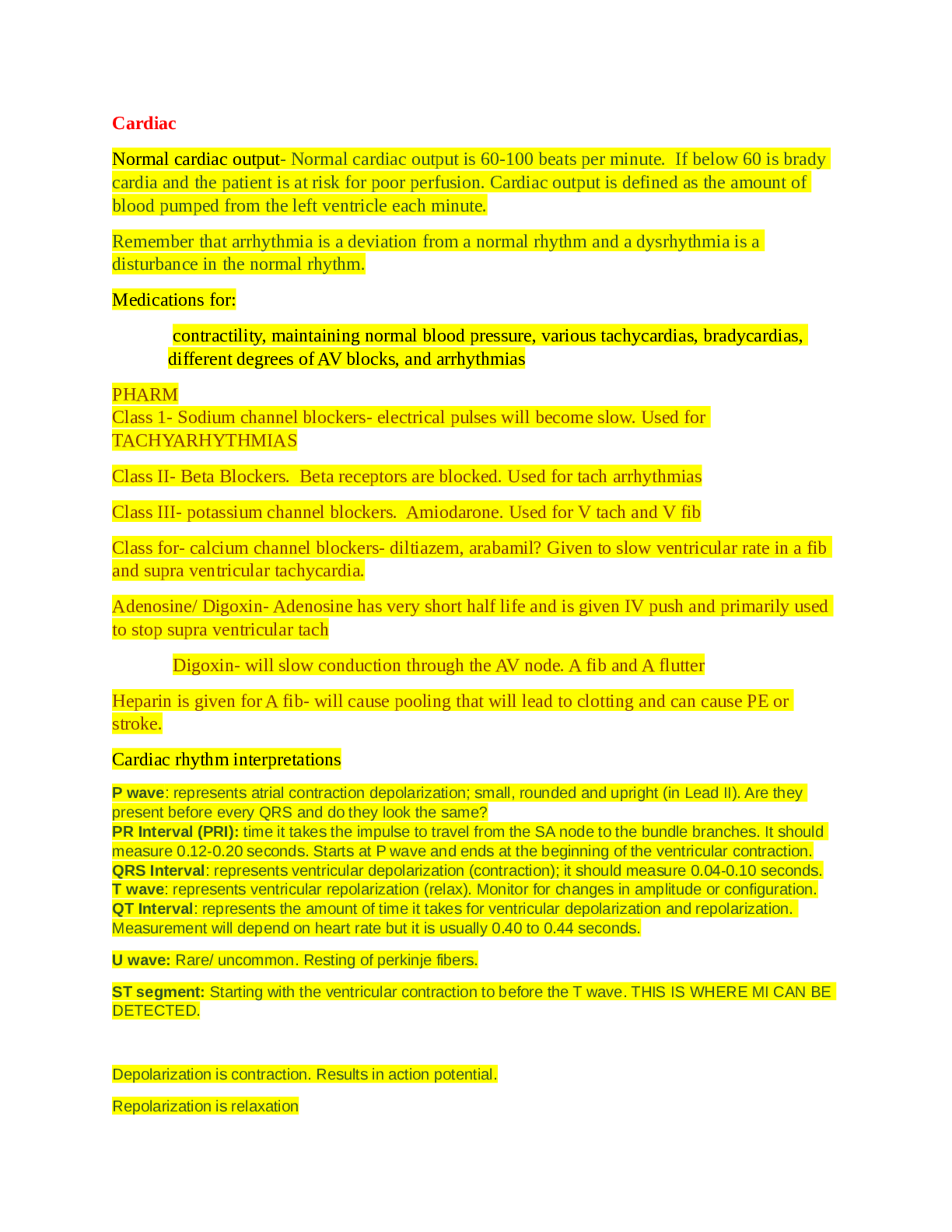*NURSING > EXAM REVIEW > Chamberlain College of Nursing PATHO NR283 exam 2 review (All)
Chamberlain College of Nursing PATHO NR283 exam 2 review
Document Content and Description Below
Circulatory system ● Cardiovascular system ● Lymphatic system ● Moves O2, nutrients, remove wastes ● arteries/ arterioles ○ Transport blood away from heart/ deoxygenated blood ● vein... s/ venules ○ Return blood back to heart ● Capillaries ○ Microcirculation within tissue ● Systemic circulation ○ Exchange gases, nutrients, wastes in tissue ● Pulmonary circulation ○ Gas exchange in lung ● CO2/ acid Blood ● plasma/ 55% ○ Proteins ■ Osmotic pressure, antibody, blood clots ■ Yellowish fluid, clear ■ Albumin: osmotic pressure ■ Globulins: antibodies ■ Fibrinogen: clotting ● Hematocrit: % of rbc ○ More rbc, increased viscosity, increased osmolarity ● Rbc: transport O2 + CO2 ● Erythrocytes: rbs ○ Hemoglobin: red color in rbc ■ Globin portion ■ Heme group ○ 120 days alive ○ Erythropoietin produced in kidney stimulates erythrocyte production ● Leukopenia: low wbc ● Thrombopenia: low platelet ● Cytosis increases Clotting ● Steps ○ vasoconstriction/ vasospasm after injury○ Platelet clot ○ Coagulation mechanism ● Plasmin eventually break down blood clot ● Tpa given for strokes Typing ● Based on antigens in plasma membrane of erythrocytes ● RH system ○ Antigen D in plasma membrane/ Rh+ ○ No antigen D/ RhBlood group RBC antigens Antibodies in plasma Donor blood group for transfusion O none Anit-A +Anti-B O A A Anti-B O A B B Anti-A O B AB A + B none O AB AB Blood dyscrasia ● Abnormal pathologic condition of blood ○ Genetics ○ Malnutrition ○ Trauma ○ Cancer ○ Chemotherapy ○ Chronic disease/ cirrhosis ○ Renal failure ○ Surgery ○ Rx ○ Toxins ○ Sepsis Decreased rbc/ sob, fatigue, paleAnemia ● Reduced O transport ○ Due to hemoglobin deficit ■ Leads to ● Less energy production in all cells ● Tachycardia + peripheral vasoconstriction/ compensation mechanisms ● Signs ○ Fatigue ○ pallor/ pale face ○ Dyspnea ○ Tachycardia ○ Decreased regeneration of epithelial cells ■ Digestive tract becomes inflamed + ulcerated/ leads to stomatitis ■ Inflamed + cracked lips ■ Hair + skin/ degenerative changes ○ Severe anemia lead to angina or congestive heart failure, CHF ■ Heart attack ■ Chest pain ■ Angina Iron deficiency anemia Insufficient Fe impairs hemoglobin synthesis Etiology o Dietary intake/ Fe below minimum o Chronic blood loss o Impaired duodenal absorption of Fe o Severe liver disease/ helps with Fe absorption, storage S+s o General Pallor Fatigue Lethargy CNS stimulation/ hypoxia o Spoon shaped, ridged nails/ brittle hair o Stomatitis/ glossitis/ menstrual irregularities/ delayed healing Pernicious anemia/ Vit B12 deficiency Lack of intrinsic factoro Secreted by gastric mucosa/ required for intestinal absorption of Vit B12 Large, immature, nucleated erythrocytes Vit B12 needed for function and maintenance of neurons Etiology o Dietary insufficiency o Malabsorption Chronic gastritis/ common in alcoholics + causes atrophy of gastric mucosa or inflammation condition o Surgery/ gastrectomy S+s o Tongue typically enlarges, red, sore, shiny o Digestive discomfort/ with nausea and diarrhea o Feeling of pins + needles/ tingling in limbs Aplastic anemia Impairment/ failure of bone marrow leading to loss of stem cells + pancytopenia o Pancytopenia: decreased # of erythrocytes, leukocytes, platelets in blood Etiology o Myelotoxins: radiation, industrial chemicals, Rx o Genetic abnormalities, hep C, SLE S+s o Blood count indicate pancytopenia/ low levels, rbc, wbc, platelelts Anemia/ pallor, weakness, dyspnea Leukopenia/ recurrent infection Thrombocytopenia/ petechiae Sickle cell anemia Cause o Genetics Autosomal recessive disorder More common in african ancestry Both parents have to carry trait Abnormal hemoglobin Occurs when O2 levels lowered o Lung infection/ dehydration Sickle-shaped cells/ shorter lifespan/ anemia S+so Pallor/ weakness/ tachycardia/ dyspnea o Sever pain due to ischemia of tissues + infarction/ rbc clot easily o Jaundice/ hyperbillirubinema o Rbc clump/ cause hypoxia Anemia Rbc Eiology Additional effects S+s Fe deficient Microcytic Hypochromi c Decreased hemoglobin production Decreased dietary intake Malabsorptio n Blood loss Only effects of anemia General: Pallor/ Fatigue/ Lethargy/ CNS stimulation, hypoxia Spoon shaped, ridged nail, brittle hair Stomatitis, glossitis, menstrual irregularities, delayed healing Pernicious Megaloblast s Short lifespans Deficit of intrinsic factor due to immune reaction Neurologic damage Achlorhydria Tongue typically enlarges, red, sore, shiny Digestive discomfort/ with nausea and diarrhea Feeling of pins + needles/ tingling in limbs Aplastic Normal cells Pancytopeni a Bone marrow damage/ failure Excessive bleeding Multiple infections Blood count indicate pancytopenia/ low levels, rbc, wbc, platelelts Anemia/ pallor, weakness, dyspnea Leukopenia/ recurrent infectionThrombocytope nia/ petechiae Sickle cell Sickle shape when O2 levels low Short lifespan Recessive inheritance Painful crises with multiple infarction hyperbilirubine mia Pallor/ weakness/ tachycardia/ dyspnea Sever pain due to ischemia of tissues + infarction/ rbc clot easily Jaundice/ hyperbillirubine ma Rbc clump/ cause hypoxia Polycythemia Primary/ polycythemia vera o Increased production of erythrocytes + other cells in bone marrow o Neoplastic disorder o Serum erythropoietin levels low 2nd / erythrocytosis o Increase in rbc in response to prolonged hypoxia/ copd, high elevation o Increased erythropoietin secretion o Compensation mechanism to provide increased O2 transport Increased elevation S+s o Plethoric + cyanotic Deep bluish-red tone of skin and mucosa resulting from engorged blood vessels and sluggish blood flow o Hepatomegaly o Increased blood pressure o Thromboses + infarctions o Chf can develop Blood clotting disorder Spontaneous bleeding/ excessive bleeding following minor tissue trauma Warning signs o Persistent bleeding from gums, petechiae, bruises, ecchymosis Complication o Risk for hemorrhage/ invasive procedure Hemophilia A Classic hemophilia/ deficit, abnormality of factor VIII o X-linked recessive trait o Manifested in men/ carried by women S+s o Prolonged bleeding after minor tissue trauma o Spontaneous bleeding into joints o Hematuria (blood in urine) or blood in feces Leukemias Neoplastic disorders involving wbc Undifferentiated, immature, nonfunction cells that multiply uncontrollable/ infection, uncontrolled Acute o High proportion of immature nonfunctional cells o Onset usually abrupt/ marked signs of complications o Occurs primarily in kids+young adults Chronic o Higher proportion of mature cells with reduced function o Insidious onset o Common in older adults S+s o Frequent/ uncontrolled infections o Weight loss, fatigue, possible fever Tests Complete blood count o Total rbc, wbc, platelets Leukocytosis/ increased wbc o Inflammation/ infection Leukopenia/ decreased wbc o Viral infection/ radiation/ chemotherapy Increased eosinophils [Show More]
Last updated: 2 years ago
Preview 1 out of 57 pages

Buy this document to get the full access instantly
Instant Download Access after purchase
Buy NowInstant download
We Accept:

Reviews( 0 )
$12.00
Can't find what you want? Try our AI powered Search
Document information
Connected school, study & course
About the document
Uploaded On
Aug 06, 2021
Number of pages
57
Written in
Additional information
This document has been written for:
Uploaded
Aug 06, 2021
Downloads
0
Views
91




.png)


.png)





